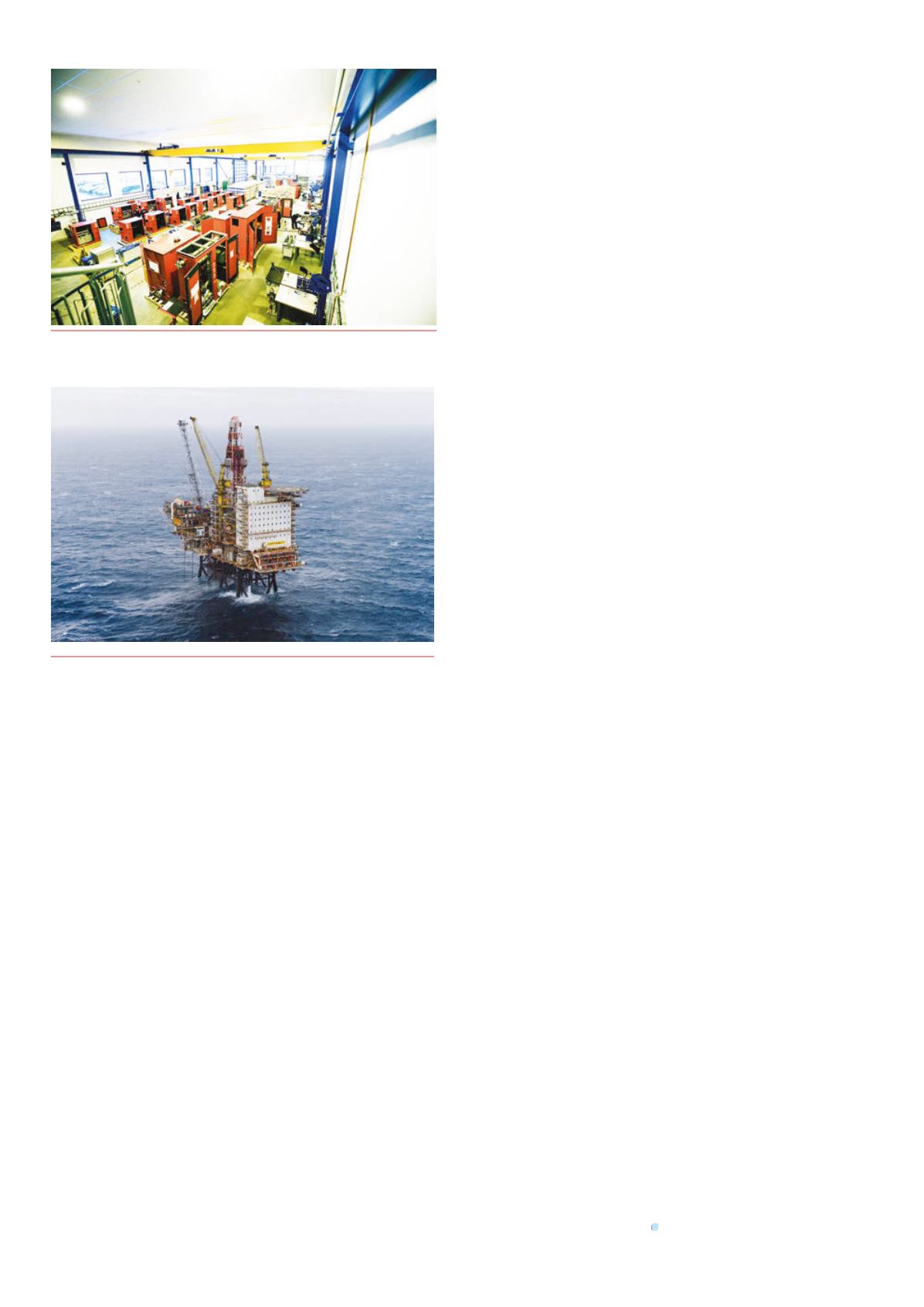
68 |
Oilfield Technology
December
2014
ALIGN’s completion of the Talisman commission is due to the company’s
extensive use of established brands fromeach of the bundled services
– pumps, fire fighting systems, safety automation and generators. Each
of the brands is a leader in its field of technical safety. Under the single
ALIGNbanner, with the particular focus on total fire fighting solutions, the
company can offer this type of comprehensive solution for customers in
the oil and gas industry. Instead of a service company buying the hardware,
ALIGNworks directlywith the end‑user, managing the project right fromthe
design phase to complete solution.
Wirelessconsolidation
Safety automation is a field exposing rapid technological development in
the oil and gas industry. A transfer fromcabled towireless instrumentation
can provide significant savings for offshore operations and projects alike,
but large‑scale implementation is hampered by fragmented standards and
protocols. Wireless instrumentation is still primarily used as an add‑on to
existing cabled systems for upgrades to gas detection systems.
As an independent group of experts, Origo Solutions, part of ALIGN, has
commissionedwireless equipment fromseveral suppliers to test integration
and functionality between them. The strategy is to provide fully operative
solutions to the customer. Whenwireless is chosen for larger upgrades, the
next phase of the development will be reached. The third and last phase
arriveswhen the operators choose fullywireless systems.
There aremany factors to consider inmodifyingwired systemswhile a
platform is operational. Awireless systemcan however develop in parallel,
while the old systemoperates. Wireless systems also allow formuch easier
and less expensive construction of temporary detectionwhile carrying out
developments/modifications to the platforms.
Tests that have been performedwithwireless detection offshore show
savings between 60 and 80%compared towired systems. The savingswill
mainly have been due to reduced installationworks.
Traditional barriers
The predominant pattern in oil and gas projects is still to divide safety
installation procedures into the traditional sections of systemdesign, a
procurement phase and an operating phase split into components. The
prevailing assumption is that this enables price bargaining between suppliers
in themarket, aswell as an expectation of efficiency throughout the system.
History has shown that the real effect of fragmented technical safety is an
accumulation of procurements. This prevents positivewholesale effects,
increases expensive phase transactions between sub-contractors, and the
need for training personnel for one-time use.
All parties recognise the need for splitting up the construction of sizeable
infrastructure such as the topside of a platform, but the disadvantages
should not be neglected. If the industry could prevent a fragmented outfitting
through, it couldmean less cost. A newapproach to technical safetywould
make it possible to adjust dimensions and functionality between pumps, fire
water systems, other fire fighting systems and generators ultimately leading
to lower combinedweight. A practical way of dealingwith these issues is to
include safety expertise into the front end engineering design (FEED).
The safety operation of a complete system is still not firmly established
in the sector. Thus the first step formost projectmanagers is to commission
feasibility studies to envisage the change. The next step is to try out an
integrated safety concept and expertise on a smaller project. Finally the
customer should benchmark the newmethodwith traditional ones. Should
the newprocedures be favoured, they can provide technical advantages
both on a simple level and into an advanced systemwith higher safety
requirements.
Thenextoffspring
Technical safety introduced in an earlier phase of oil and gas projects is
thought to be a reality in the industry in the near future. The industry has
already identified all the factors necessary to facilitate a shift: a need for less
bureaucracy, higher technical safety due to increasing levels of regulations, a
need to bemore cost-effective in all parts of construction andmodifications,
aswell asmore efficiency during construction and installation.
Offshore oil and gas exploration and production is a relatively young
industry, and ALIGNhas seen a series of technical sections consolidating
themselves into fully independent supply sectors. Drilling and subsea
might exemplify how the operators gradually have transferred trust and
responsibility to external contractors, allowing themto specialise and be
more cost‑effective in order to relieve the operator of demanding technical
environments that they do not need. By bundling pumps, automation
and detection aswell as active fire fighting systems, all arising from
well‑established companies, ALIGNhas acquired the experience to assume
responsibility for technical safety as part of the next offspring sector within oil
and gas.
Cost‑awareness
A driver towards developing amore independent safety sector is the oil and
gas industry’s growing cost‑awareness. As the natural resources become
more scarse, the threshold for developing newoil and gas fields requires a
continuous reduction in project costs related to output. At the same time
personnel expenses are soaring, and improvedHSE&Q standards are taking
their toll across the project architecture.
The industrywill have to domorewith fewer resources. Being able to
reduce the complexity, time and cost for clients by using the toolboxes,
projectmanagement skills, hands‑on expertise and products from
consolidated supplierswill be paramount. Integration of technical safetywill
play a crucial part in the future, making operations safer, more cost‑efficient
and improving the bottom‑line.
Figure 1.
Fire Protection Engineering, Part of ALIGN, ProductionHall
Stavanger, Norway - Fire Fighting Systems.
Figure 2.
Platform in theGyda oilfield located in the southern
Norwegian section of North Sea. (Photo courtesy of Talisman Energy.)


